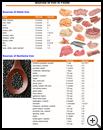
Iron Overload Disease (Hemochromatosis)
________________________________________________________________________
KEY POINTS
- Iron overload disease is a condition that causes iron to build up in your body. This disease is also called hemochromatosis. The buildup of iron can damage or destroy organs.
- The treatment is to remove excess iron from your body by removing blood. Your blood is taken the same way it is when you donate blood. If you have the gene that causes your body to absorb too much iron from the food you eat, your provider may suggest changes to your diet.
- Ask your provider how to take care of yourself at home, what symptoms or problems you should watch for, and what to do if you have them.
________________________________________________________________________
What is iron overload disease?
Iron overload disease is a condition that causes iron to build up in your body. This disease is also called hemochromatosis.
The buildup of iron can damage or destroy organs. The buildup of iron in the body can cause:
- Scarring of the liver, called cirrhosis, which may cause your liver to stop working
- An irregular heartbeat or weak heart muscle
- Diabetes (caused by damage to the pancreas)
- Erectile dysfunction (ED) or impotence, which is trouble having an erection or keeping an erection firm enough for sex
If the disease is found early, it can be treated and the damage can be prevented.
What is the cause?
The most common causes of iron overload disease are:
- Having frequent blood transfusions to treat certain kinds of anemia
- Taking too many iron supplements
- Inheriting a defect in the genes that controls how much iron your body absorbs from food. Genes are in each cell of your body. They contain the information that tells your body how to develop and work. Changes in the genes can be passed from parents to children.
Iron overload disease is more common in people of English, French, Swedish, or Portuguese descent.
What are the symptoms?
You may not have any symptoms for years. Symptoms usually start in middle age. They include:
- Feeling tired (the most common symptom)
- Arthritis (joint pains, especially in the fingers, hips, and knees)
- A change in your skin color to gray or brown
- Fast or irregular heartbeat
- Problems having or keeping an erection
- Irregular or no menstrual periods
- Trouble getting pregnant
- Symptoms of diabetes, such as being very thirsty and urinating a lot
- Symptoms of liver problems, such as nausea, loss of appetite, swelling of the belly, stomach pain, and vomiting of blood
Men may start having symptoms between 30 and 50 years of age. Women often don’t start having symptoms until menopause. Before menopause women are protected somewhat from the disease because they lose iron when they have periods and during childbirth.
How is it diagnosed?
Your healthcare provider will ask about your symptoms and medical history and examine you. Tests may include:
- Blood tests
- CT scan, which uses X-rays and a computer to show detailed pictures of the liver
- MRI, which uses a strong magnetic field and radio waves to show detailed pictures of the liver
- In some case, a liver biopsy may be taken to help make a diagnosis. A biopsy is the removal of a small sample of tissue for testing.
How is it treated?
The treatment is to remove excess iron from your body by removing blood. Your blood is taken the same way it is when you donate blood. When your level of iron is high, you may need to have a pint of blood removed once or twice a week for several months. Your iron levels will be checked with blood tests to know how much blood needs to be taken. When your iron levels are back to normal, you will probably need to repeat the treatment every 2 to 4 months to keep normal levels.
If you have the gene that causes your body to absorb too much iron from the food you eat, your provider may suggest changes to your diet. You may also need to avoid iron and vitamin C supplements, both of which are in many multiple vitamins. Vitamin C helps your body absorb more iron.
You may need treatment if iron damage to your organs has caused:
- Diabetes
- Thyroid problems
- Erectile dysfunction
- Heart disease
- Joint pain
To help prevent liver damage, avoid drinking alcohol. You should also avoid taking medicines that can damage the liver more, such as acetaminophen.
How can I take care of myself?
- Follow your healthcare provider's instructions for taking medicine.
- Eat a healthy diet according to your provider’s instructions.
- Don’t drink alcohol.
- Ask your provider:
- How and when you will get your test results
- How long it will take to recover
- If there are activities you should avoid and when you can return to your normal activities
- How to take care of yourself at home
- What symptoms or problems you should watch for and what to do if you have them
- Make sure you know when you should come back for a checkup.
How can I help prevent iron overload disease?
If you have a family history of iron overload disease, you should have tests to see if you have the disease or if your iron levels are getting too high. With early diagnosis and treatment, organ damage caused by iron overload disease can be prevented.

